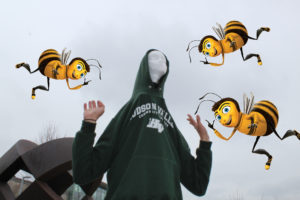Killer bees attack student
Eoz Deno
The Evil Twin of the News Editor

Hudson Valley student and liberal arts major David Aguado accidently avoided a math test after a swarm of killer bees attacked him.
“This is really a blessing in disguise,” Aguado said. “If it weren’t for the bees, I would have had to take my algebra test that I hadn’t studied for.”
Aguado was walking to his math class in the Administration Building when he stepped in a ground hive. The killer bees attacked him in a swarm and Public Safety had to intervene.
“I didn’t know what to do,” said Public Safety Officer Kenny Spunk. “Luckily, I watched a cartoon once where this happened and the bees were killed with water.”
Spunk tried to throw a bucket of water on the bees without success. His co-worker, Public Safety Officer Jared Hazes, was able to spray the bees with a hose and drag Aguado to safety.
An ambulance brought Aguado to the ICU, where he remained for 24 hours. He is expected to make a full recovery.
“It was really scary, Aguado said. “I used to laugh when Winnie the Pooh was chased by the honey bees, but this really changed my perspective. I thought I might die. It still wasn’t as scary as my math test, though.”
He said he would have definitely died if he had taken the test.
Two Public Safety officers also received medical assistance for stings received while they were trying to contain the bees.
“This wasn’t what I signed up for,” Spunk said. “I thought I was signing up to deal with brain-dead potheads and the occasional rowdy man-child trying to turn his life around.”
The killer bees that attacked Aguado are officially called the Africanized honey bees. They are the first of their species to be seen in Upstate New York. The species was bred in the 1950s. The breeding was part of an effort to heighten honey production in Brazil by biologist Warwick Kerr.
In 1957, 26 swarms of bees escaped the quarantine and have been migrating northward since. The killer bees were first found on U.S. soil at an oil field in the San Joaquin Valley of California in 1985.
Experts at the University of Illinois’ Department of Entomology say there are roughly 40 fatal “killer” bee attacks each year. The fatality rate is linked to the number of stings a victim receives, rather than venom. Killer bees are faster than other bees and have been known to chase humans a quarter of a mile.
Public Safety, with the assistance of local law enforcement, will be searching the rest of the campus for any other hives.
Hudson Valley released the following statement: “What happened to David Aguado is extremely unfortunate. Hudson Valley is a safe place for students, and it is important to keep in mind this was just one isolated incident that in no way reflects the future.”
